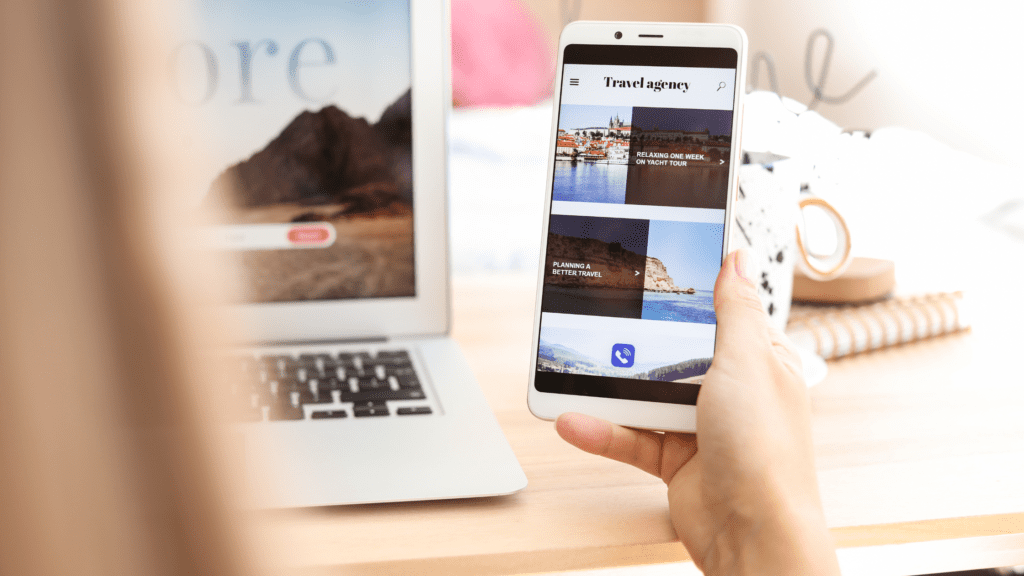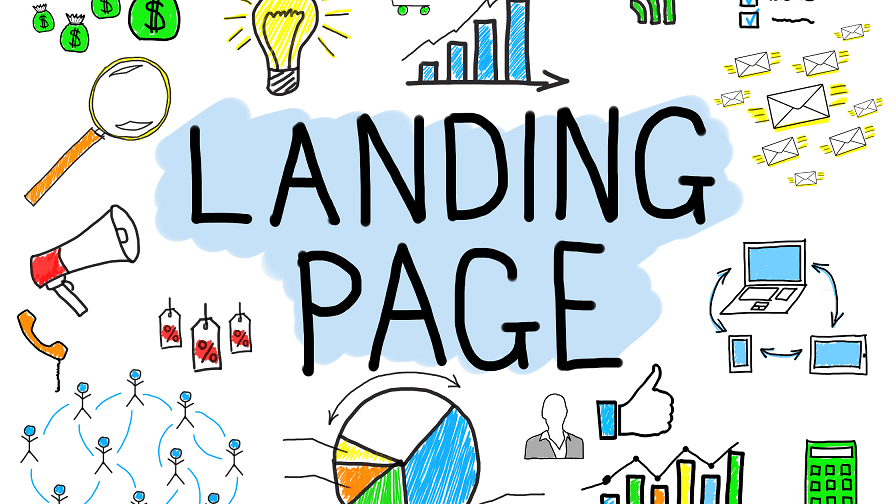You frequently visit landing pages while you navigate and surf the internet. The page you are directed to when you click on an advertisement might be referred to as a landing page. To build your first landing page, you need to be intentional and have a clear focus. It can also be the page that appears after a call to action button or acts as a website’s main page.
The goal of a landing page is to persuade you to become a lead or customer, regardless of how you “land” there. Because of this, landing pages are particularly effective parts of a company’s digital marketing strategy.

What are Landing Pages?
Landing pages are standalone web pages that are specifically created for marketing or advertising purposes. Their primary objective is to capture the attention of website visitors and convert them into leads or customers.
Landing pages often have a specific focus and are designed with a clear call-to-action (CTA). For example, they may be used to promote a product, encourage sign-ups for a newsletter, or offer a free download in exchange for contact information.
The content and layout of landing pages are carefully crafted to be concise, visually appealing, and persuasive. They typically remove any distractions that could divert visitors away from the desired action, such as navigation menus or external links. By keeping the visitor’s attention focused on the call-to-action, landing pages can increase conversion rates and drive targeted engagement.
What is an All-in-One Platform?
An all-in-one platform is a comprehensive piece of software or a service that offers a variety of tools and capabilities to serve different functions within a company or organization. It is intended to combine several functionalities into a single platform, doing away with the requirement for using various different tools or services.
Website creation, marketing automation, customer relationship management (CRM), email marketing, e-commerce, analytics, social media management, project management, and other features are frequently provided by an all-in-one platform. The objective is to give organizations a central location where they can effectively manage many parts of their operations.
Businesses may enhance productivity, lower expenses, and streamline workflows by utilizing an all-in-one platform. They no longer need to handle multiple subscriptions or switch between tools with various interfaces. Additionally, an all-in-one platform frequently offers greater tool integration, enabling seamless data flow and more efficient decision-making. An all-in-one platform provides a complete collection of capabilities in a single package, making it easier to manage a company’s online presence, marketing initiatives, client interactions, and other crucial processes.

Why Create a Landing Page?
Your first landing page definitely has its several important purposes for businesses and marketers.
- Conversion and Lead Generation – Landing pages are specifically designed to convert website visitors into leads or customers. By focusing on a single call-to-action and removing distractions, landing pages can significantly improve conversion rates. They provide a targeted and persuasive experience to encourage visitors to take the desired action, such as filling out a form, making a purchase, or signing up for a service.
- Targeted Marketing Campaigns – Landing pages allow businesses to create highly targeted campaigns for specific products, services, or promotions. By tailoring the content, design, and messaging to a specific audience or segment, businesses can increase the relevance and effectiveness of their marketing efforts. Landing pages provide a platform to showcase the unique value propositions and benefits of a specific offer, helping to attract and convert the right audience.
- Data Collection and Insights – Landing pages incorporate lead capture forms, allowing businesses to collect valuable information from their visitors, such as names, email addresses, or preferences. This data can be useful for personalizing future marketing campaigns, segmenting the audience, and understanding customer behavior. Landing pages often integrate with analytics tools to provide insights into visitor behavior, conversion rates, and other metrics, enabling businesses to optimize their marketing strategies and make data-driven decisions.
Related Article: 7 Key Elements of High-Converting Landing Pages
Benefits of Having Your First Landing Page in Your Website
- Increased Conversion Rates – Landing pages are designed with a specific call-to-action (CTA) in mind, whether it’s to make a purchase, submit a form, sign up for a newsletter, or download a resource. By removing distractions and focusing on a singular goal, landing pages can significantly enhance your conversion rates. Visitors are more likely to take the desired action when presented with a clear and compelling offer on a dedicated landing page.
- Better Targeted Marketing -Landing pages allow you to create targeted marketing campaigns for specific products, services, or promotions. By tailoring the messaging, design, and content to a particular audience or segment, you can increase the relevance and impact of your marketing efforts. Landing pages enable you to highlight the specific value proposition and benefits of your offering to attract and engage the right audience.
- Improved Data and Insights – Landing pages incorporate lead capture forms, enabling you to collect valuable customer information such as names, email addresses, and preferences. This data can be useful for personalizing future marketing campaigns, segmenting your audience, and gaining insights into customer behavior. By integrating landing pages with analytics tools, you can obtain valuable data on visitor behavior, conversion rates, and other metrics, allowing you to optimize your marketing strategies and make informed decisions.
- Enhanced Brand Awareness and Credibility – Landing pages can solidify your brand presence and establish credibility. By providing focused and engaging content on a dedicated page, you can showcase your expertise and value proposition, instilling confidence in your visitors. Well-designed landing pages with relevant and persuasive content also help create positive brand associations, leading to increased brand awareness and recognition.
- A/B Testing and Optimization – Landing pages provide an ideal environment for A/B testing and optimization. By experimenting with different elements such as headlines, copy, images, layouts, and CTAs, you can identify the most effective combinations. Through continuous testing and optimization, you can refine your landing pages to maximize conversions and improve overall performance, ultimately driving better results and return on investment.

25 Tips in Building Your First Landing Page
- Define your goal – Clearly identify the purpose of your landing page. Whether it’s to generate leads, promote a product, or drive traffic to a specific page, knowing your goal will help shape your design and messaging.
- Understand your target audience – Research your target audience’s demographics, interests, and pain points. This knowledge will allow you to tailor your landing page to their needs and preferences.
- Keep it simple – Avoid cluttering your landing page with unnecessary elements. A clean and simple design will make it easier for visitors to understand and navigate.
- Craft a compelling headline – Your headline should grab attention and convey the unique value proposition of your offering. Make it concise, engaging, and relevant to the visitor.
- Use engaging visuals – Including high-quality images or videos can help capture visitors’ attention and enhance the overall visual appeal of your landing page.
- Create a strong call to action (CTA) – Clearly communicate the action you want visitors to take, such as “Sign up now” or “Get started.” The CTA should stand out visually and be compelling.
- Highlight the benefits – Clearly communicate the benefits that visitors will gain by taking the desired action on your landing page. Showcase how your offering solves their problems or fulfills their needs.
- Use persuasive copy – Use concise and persuasive copy that effectively communicates your message. Address the pain points of your audience and provide clear solutions.
- Include social proof – Display testimonials, customer reviews, or case studies to build trust and credibility. Showcasing positive experiences from previous customers can help persuade new visitors.
- Use relevant and concise forms – If you require visitors to fill out a form, make it simple and ask for only necessary information. Long and complicated forms can deter conversions.
- Optimize for mobile devices – Ensure your landing page is mobile-friendly and responsive. Many visitors will access your page on their smartphones, so it’s important to provide a seamless experience across devices.
- Use compelling headlines and subheadings – Break up your content with clear and concise headings. This helps visitors scan your page easily and understand the key points.
- Add trust seals and security features – If applicable, display trust badges or security icons to demonstrate that your landing page is secure and trustworthy.
- Test different versions – Conduct A/B testing to compare different versions of your landing page. Test elements like headlines, CTA buttons, forms, or color schemes to identify what resonates best with your audience.
- Limit distractions – Remove unnecessary links, navigation menus, or any elements that may divert attention from your primary call to action. The focus should be on guiding visitors toward your desired conversion.
- Use white space strategically – Utilize white space to give your landing page a clean and uncluttered look. This helps focus attention on your key message and desired action.
- Optimize page load speed – Ensure your landing page loads quickly to prevent visitors from losing interest or abandoning the page. Compress images and minimize code to improve load times.
- Include relevant keywords – Optimize your landing page with relevant keywords related to your offering. This can help increase the chances of your page being discovered through search engines.
- Add social media sharing buttons – Make it easy for visitors to share your landing page with their networks. This can help expand your reach and potentially attract more visitors.
- Monitor analytics – Use web analytics tools to monitor the performance of your landing page. Analyze metrics like bounce rate, conversion rate, and time spent on page to gain insights and make data-driven improvements.
- Personalize the experience – Use dynamic content to tailor your landing page based on the visitor’s location, interests, or other relevant information. This can help create a more personalized and engaging experience.
- Showcase testimonials – Including testimonials, success stories, or case studies can add credibility to your offering. Highlight positive experiences from satisfied customers to build trust.
- Use clear and concise language – Avoid using jargon or complex terminology in your copy. Keep your messaging simple and easy to understand, ensuring it resonates with your target audience.
- Create a sense of urgency – Use limited-time offers, countdown timers, or scarcity tactics to create a sense of urgency and encourage visitors to act quickly.
- Continuously optimize – Regularly review and refine your landing page based on visitor feedback and data analysis. Make incremental adjustments to improve its effectiveness over time.
Pros and Cons of Landing Pages
Pros of Landing Pages
- Landing pages are specifically designed to convert visitors into leads or customers, with a clear call to action and focused messaging.
- Landing pages allow you to tailor your message to a specific audience or campaign, ensuring relevance and resonance.
- By capturing visitor information through forms on landing pages, you can generate qualified leads for further nurturing.
- Landing pages enable you to track and measure conversion rates and other key metrics, providing valuable insights for optimization.
- A well-designed landing page with testimonials, social proof, or trust seals can enhance your brand’s credibility and trustworthiness.
- Through a clear and simple layout, landing pages provide a seamless user experience, enabling visitors to quickly understand the offer and take action.
Cons of Landing Pages
- Landing pages are typically limited to a single campaign or offer, which may not be suitable for businesses with diverse products or services.
- Building effective landing pages requires time and effort, including creating persuasive copy, designing the page, and setting up tracking mechanisms.
- Depending on the complexity of your landing page requirements, you may need technical expertise for design or development.
- If you’re running paid advertising campaigns to drive traffic to your landing page, you will incur costs for clicks or impressions.
- The focus on conversion may limit the space for additional information or storytelling, which could be important for certain products or services.
- Landing pages may not rank highly in search engine results unless you invest in search engine optimization strategies.

Conclusion
In conclusion, landing pages have a number of benefits for companies wanting to increase conversions and accomplish particular marketing objectives. They offer a concentrated and targeted strategy to engage customers, communicate pertinent information, and motivate them to perform the desired action. Landing pages can increase lead generation, give quantifiable outcomes, boost trust, and improve user experience.
It’s crucial to take into account any potential disadvantages, though. Landing pages need time and effort to develop, may call for technical expertise, and may cost money if paid advertising campaigns are being used. They might also be constrained in scope and less suited to companies with a wide range of products or intricate stories to tell.
The choice to use landing pages should be founded on a rigorous analysis of your company’s requirements, objectives, and target market. Landing pages may be a potent tool in your marketing plan to boost conversions and accomplish targeted results when used properly.
Start your 14-day Trial today to start and launch your first landing page.

